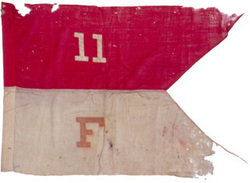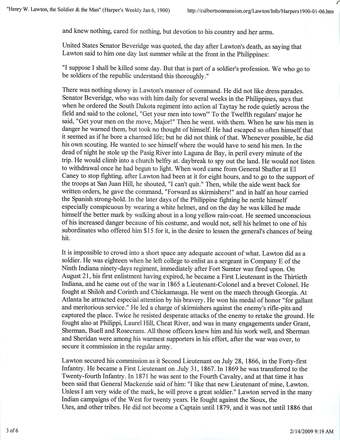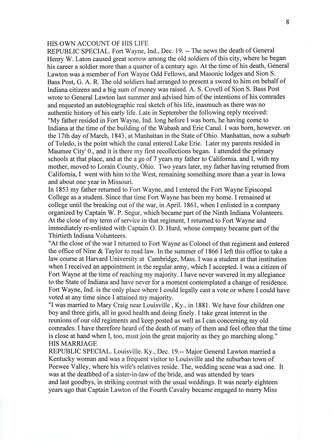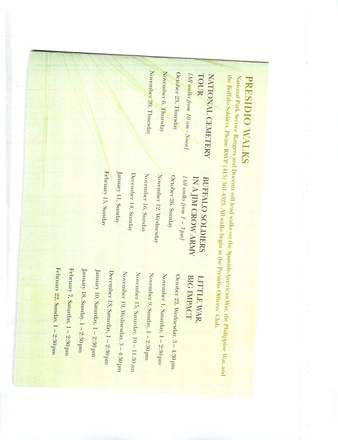

OBVERSE

REVERSE













Book Photo

Obverse - 2

Guidon in the Field

Acquisition Photo

Acquisition Photo

Acquisition Photo
U.S. Guidon, 11th Cavalry, General Henry Lawton.
Sub-collection: de Young MuseumU.S. Army "Model 1885" Cavalry Guidon; 11th Cavalry, Second Squadron, Troop F.
The red over white swallow tailed guidon has been used by the United States Cavalry since at least 1834 (although it was not issued from 1862 to 1885). The regimental number and troop letter typically appear in reverse coloration for easy identification. Guidons inspired pride in the troop that bore it, but also they also allowed each cavalry member to know where his unit was heading on the trail or in battle.
This particular guidon was carried during the American-Philippine War, and is associated with Major General Lawton, to whom the Apache, Geronimo, had surrendered the previous decade. General Lawton, of the US Army Volunteers was killed at Station San Mateo in Manila on December 19, 1899, during the "Philippine Insurrection". His escort was troop F of the 11th Volunteer Calvary, who later conveyed his body to Manila, and then presumably on to San Francisco, California for an elaborate memorial service prior to the departure of his remains for burial.
The guidon of his unit was then presented to a Red Cross benefit held in San Francisco at the Palace Hotel early in World War I. The $100 realized by its auction on June 27, 1917, was donated to the Red Cross. The flag was then donated to the city of San Francisco three days later by George Rolph and eventually was added to the collection of the De Young Museum.
The wool bunting field is cut swallow-tailed and is composed of 2 horizontal bars, each about 13.5 inches wide. The top bar is red, bottom bar is white. The upper bar bears the block figures "11" in red cotton; the lower bar bears the block letter "F" in red (now faded to a shade of orange). The flag is hand stitched with cotton thread.
Exhibition History:
First Presidio Exhibit
(ZFC0210)
United States Army Model 1885 Cavalry Guidon, Troop F, 11th U.S. Cavalry
Second Presidio Exhibit, 2003 - GALLERY VI
(ZFC0210)
United States Army Model 1885 Cavalry Guidon, Troop F, 11th U.S. Cavalry
War & Dissent
The US in the Philippines 1898 - 1915
October 22, 2008 to February 22, 2009
Publication History:
Madaus, Howard M., Dr, Whitney Smith, The American Flag: Two Centuries of Concord and Conflict. Santa Cruz: VZ Publications, 2006, p. 109.
Provenance: Acquired by the Zaricor Flag Collection (ZFC0210) in 1997 from the De Young Museum Collection through Butterfield & Butterfield Auctions of San Francisco, CA.
Deaccessed Heritage Auctions - 13 November 2023 - Auction 6276
ZFC Significant Flag
Item is Framed
Provenance:
• 11th U.S. Volunteer Cavalry, Troop f., 1899.
• Acquired by S. & G. ((Solomon & Gustav) Gump (store) San Francisco, CA, until 1917.
• Sole via Red Cross Benefit Auction, Palace Hotel, San Francisco to George Rolph, 27 June 1917.
• Mr. George Rolph ( The brother of S.F. mayor James Rolph), 1917.
• Gifted to de Young Museum, 30 June 1917.
• Sold via Butterfield & Butterfield Auctions, SF, CA, to the Zaricor Flag Collection, 1997
Sources:
Madaus, Howard M.- Whitney Smith, The American Flag: Two Centuries of Concord and Conflict, VZ Publications, Santa Cruz, 2006.
Quartermaster General US Army, U.S. Army Uniforms and Equipment, 1889, reprint, University of Nebraska Press, Lincoln, 1986.
Henry Ware Lawton, Wikipedia, 25 October 2011, from: http://en.wikipedia.org/wiki/Henry_Ware_Lawton
Dumindin, Arnaldo, Dec. 19, 1899: General Henry Lawton dies at San Mateo, Philippine American War, 1899-1902, 25 October 2011, from:
http://philippineamericanwar.webs.com/genlawtondies1899.htm
Maj. Gen. Henry W. Lawton, "General Walton", 1843-1899, Annie Fellows Johnston and the Little Colonel Stories, 25 October 2011, from: http://www.littlecolonel.com/People/Waltons/General_Walton.htm
Image Credits:
Zaricor Flag Collection
Articles and Documents on General Lawton, The Samuel Culbertson Mansion, 26 October 2011, from: http://culbertsonmansion.net/Lawton_Bio.htm
Hoist & Fly | |
|---|---|
| Width of Hoist | 27 |
| Length of Fly | 41 |
Stars | |
|---|---|
| Are there stars on obverse? | no |
| Are there stars on reverse? | no |
Stripes | |
|---|---|
| Number of Stripes | 2 |
| Color of Top Stripe | Red |
| Color of Bottom Stripe | White |
| Has a Blood Stripe? | no |
Nationality | |
|---|---|
| Nation Represented | United States |
Fabric | |
|---|---|
| Fabric | Wool |
| Comments on Fabric | Bunting |
Stitching | |
|---|---|
| Stitching | Hand |
Thread | |
|---|---|
| Thread Material | Cotton |
Attachment | |
|---|---|
| Comments on Method of Attachmen | Sleeve |
Condition | |
|---|---|
| Condition | Bad |
| Damage | Ragged on edges (red + tan at stams, tears and bottom losses) |
| Displayable | yes |
Date | |
|---|---|
| Date | 1898 |
Exhibits | |
|---|---|
| Exhibition Copy | First Presidio Exhibit (ZFC0210) UNITED STATES ARMY MODEL 1885 CAVALRY GUIDON, TROOP F, 11TH U.S. CAVALRY Date: About 1898 Media: Wool bunting with cotton inscriptions; machine sewn Comment: In 1885, the U.S. Army changed the pattern of the guidon that was carried by the companies (troops) of cavalry regiments. The new pattern reverted to the basic design used by the mounted forces of the Army between 1833 and 1862 and consisted of a swallow-tailed field divided horizontally, red over white. The upper bar bore the cavalry regiments seniority number, while the lower bar bore the troop letter. At first provided only in silk, in 1890, a field guidon of more durable bunting was provided. This particular guidon was carried during the Spanish-American War and the Philippine Insurrection following the occupation of the Philippines by United States forces. Company F, 11th U.S. Cavalry was serving as the headquarters escort to General Lawton when he was killed at Station San Mateo in Manila on December 19th,1899. This guidon was subsequently sent to San Francisco, where it was auctioned by the Red Cross on June 27th, 1917 to raise funds to aid American soldiers destined for France during World War I. Provenance: Acquired by the Zaricor Flag Collection (ZFC0210) in 1997 from the De Young Museum Collection through Butterfield & Butterfield Auctions of San Francisco, CA. Second Presidio Exhibit, 2003 - GALLERY VI (ZFC0210) United States Army Model 1885 Cavalry Guidon, Troop F, 11th U.S. Cavalry Date: About 1898 Media: Wool bunting with cotton inscriptions; machine sewn Comment: In 1885, the U.S. Army changed the pattern of the guidon that was carried by the companies (troops) of cavalry regiments. The new pattern reverted to the basic design used by the mounted forces of the Army between 1833 and 1862 and consisted of a swallow-tailed field divided horizontally, red over white. The upper bar bore the cavalry regiments seniority number, while the lower bar bore the troop letter. At first provided only in silk, in 1890, a field guidon of more durable bunting was provided. This particular guidon was carried during the Spanish-American War and the Philippine Insurrection following the occupation of the Philippines by United States forces. Company F, 11th U.S. Cavalry was serving as the headquarters escort to General Lawton when he was killed at Station San Mateo in Manila on December 19th, 1899. This guidon was subsequently sent to San Francisco, where it was auctioned by the Red Cross on June 27th, 1917 to raise funds in support of American soldiers destined for France during World War I. Provenance: Acquired by the Zaricor Flag Collection (ZFC0210) in 1997 from the De Young Museum Collection through Butterfield & Butterfield Auctions of San Francisco, CA. War & Dissent The US in the Philippines 1898 - 1915 October 22, 2008 to February 22, 2009 At the Presidio of San Francisco, Officers Club Exhibition Hall 50 Moraga Ave, San Francisco, CA 4.e ZFC0210 framed 27 x 37 |
Publications | |
|---|---|
| Publication Copy | Madaus, Howard M., Dr, Whitney Smith, The American Flag: Two Centuries of Concord and Conflict. Santa Cruz: VZ Publications, 2006, p. 109. United States Army Model 1885 Cavalry Guidon Troop F, 11th U.S. Cavalry In 1885, the U.S. Army changed the pattern of the guidon that was carried by cavalry regiments. The new pattern reverted to the basic design used by the mounted forces of the Army between 1833 and 1862 and consisted of a swallow-tailed field divided horizontally, red over white. The upper bar bore the cavalry regiments seniority number, while the lower bar bore the troop letter. At first provided only in silk, in 1890 a field guidon of more durable bunting was provided. This particular guidon was carried during the Spanish-American War and the Philippine Insurrection following the occupation of the Philippines by U. S. forces. Company F, 11th U.S. Cavalry, was serving as the headquarters escort to General Henry Ware Lawton when he was killed at Station San Mateo in Manila on December 19th, 1899. This guidon was subsequently sent to California, where it was auctioned to support the Red Cross on June 27th, 1917 in San Francisco, to raise funds to aid American soldiers destined for France during World War I. Date: About 1898 Size: 27" hoist x 37" fly Media: Wool bunting with cotton inscriptions; machine sewn Provenance: Acquired by the Zaricor Flag Collection in 1997 from the De Young Museum San Francisco CA Collection through Butterfield & Butterfield Auctions of San Francisco, CA. ZFC0210 |

























































